London Mole Removal Treatments
Home » Treatments » London Mole Removal Treatments
Get rid Of That Malicious Mole
Not sure about your condition? Get in touch now, there is no reason for you to wait.
Award winning dermatology service, with over 20 years of experience
Short waiting lists, on some occasions offering same week appointments
Safe environment, in Care Quality Commission approved facilities
Mole Removal In London
Moles, also known as naevi, are dark spots that can appear anywhere on the body and can be raised or flat. They are made from small aggregates of melanocytes – the cells that provide the pigment in one’s skin. Sometimes moles are present at birth, but usually they develop in childhood. Genetics can play an important role in the likelihood of an individual developing moles. Sun exposure is also a causal factor. Sun damage can trigger changes in a mole that might eventually lead to cancer. It is therefore essential to protect your skin from the sun, especially if you have a lot of moles.
Moles are very common and don’t usually cause any problems. However, you might decide that you want to have a mole removed for cosmetic reasons. Your dermatologist might also recommend mole removal if there is a chance that a mole could be cancerous. Mole removal is a very straightforward procedure that can be performed by your dermatologist at the skin clinic.
Alternative names: Mole, naevus, nevus, junctional naevus, compound naevus, intra-dermal naevus, congenital melanocytic naevus, halo naevus, atypical naevus, dysplastic naevus, birthmark, epidermal naevus, naevus sebaceous, naevus lipomatosus superficialis.
WHAT DO MOLES LOOK LIKE?
Moles are usually brown but can vary from flesh-coloured, to pink, black or blue. They are sometimes flat (junctional), may be raised and rounded (intradermal) or warty looking (compound). They are usually quite symmetrical, circular and evenly pigmented. If the mole is sitting over a hair follicle then there may be hair growing out of it. The hair in a mole can look thicker or darker than hair on the surrounding skin because it may be carrying extra pigment.
However, moles can sometimes start to change. Changes in the size, shape, colour or symmetry of a mole can be a sign of skin cancer. Moles might also start to itchy, scab over or bleed when they develop into skin cancer. You should check your moles regularly for any signs that they are changing. If you notice anything unusual about a mole then you should see a doctor as it could be a sign of a developing melanoma. Melanoma can be very serious if it is left untreated, so it is important to have any suspicious moles removed and tested. If the mole did contain cancerous cells then your doctor will want to make sure that they were all removed during the procedure.
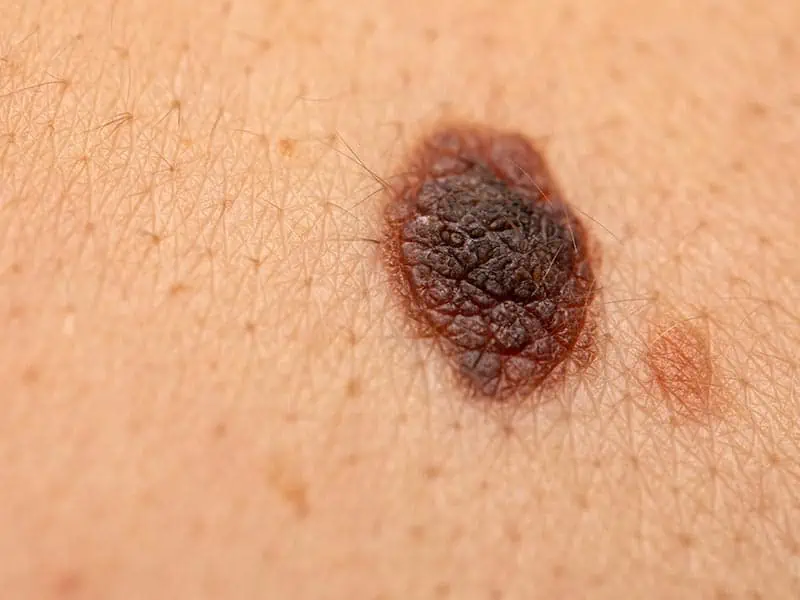
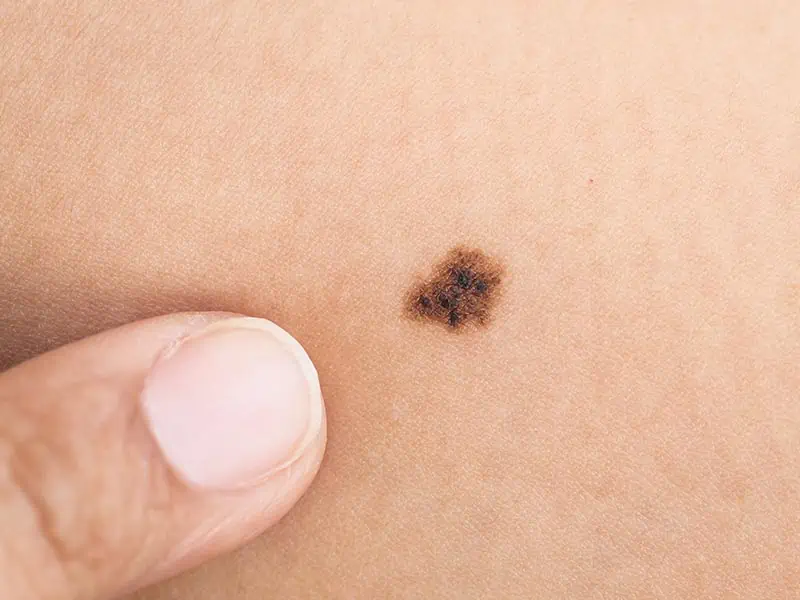
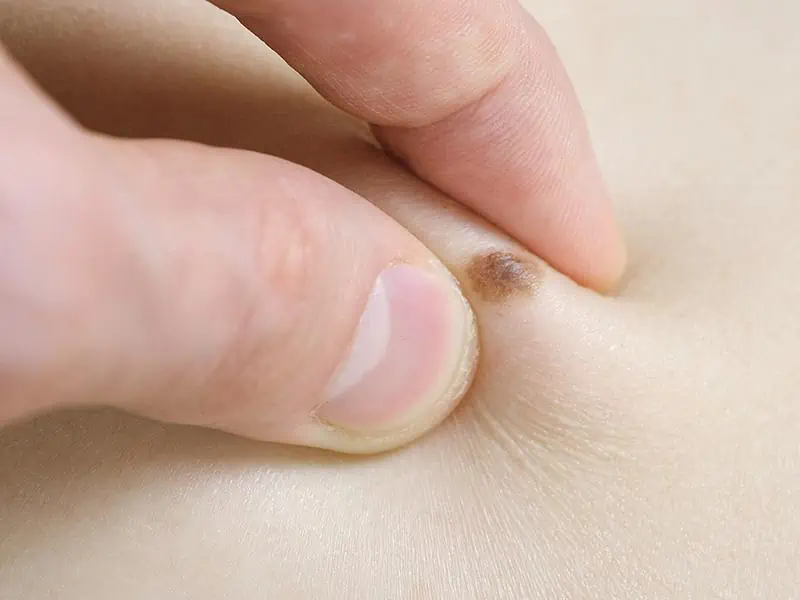
HOW CAN MOLES BE REMOVED?
Moles can be removed in different ways, depending on the location and appearance of the mole. The treatment options available to you will be discussed during your consultation with one of our consultant dermatologists. If you’d like to find out more about our mole-checking and removal services, please get in touch and we’ll be happy to answer your questions and book you in for a consultation. Some of the treatment options for mole removal at Stratum Dermatology Clinics include:
CRYOTHERAPY
Cryotherapy uses cold treatment to remove the mole. Liquid nitrogen is used to freeze the tissue, causing the area to scab over. After about a month, the scab containing the mole will fall off your skin. Cryotherapy is a local treatment so will only impact the areas exposed to the liquid nitrogen and works well in the treatment of basal skin cancer.
LASER MOLE REMOVAL
Some moles can be removed by laser treatment and if this option suits your condition you will be advised at the consultation. Laser mole removal is best suited for small moles and is a good option when the mole is on the face as there is less risk of scarring. This treatment to remove moles works by using intense bursts of light radiation to remove the cells which make up the moles and usually takes a couple of treatments to completely remove the mole.
SHAVE REMOVAL
Moles can be removed from the face and body using a shave removal technique which involves removing the mole using a scalpel. The treatment area will be numbed with anaesthesia and a small pink mark may be left where the mole once was, but this should fade over time.
EXCISION REMOVAL
Excision mole removal works by completely removing the mole by cutting it out, along with a small area of surrounding healthy tissue. This treatment is usually used to find out if the mole is cancerous. The area is treated with local anaesthetic and then the mole itself is removed along with a small area of normal skin. The wound is either stitched up or a skin graft is used to connect a patch of healthy skin from a hidden part of the body to the affected area.
Even if you’re having your moles removed purely for cosmetic reasons, we recommend that a histological analysis be carried out in order to identify any potentially dangerous cases that may require further treatment. When it comes to skin cancer, getting an accurate diagnosis is important, having your moles removed by a member of our specialist dermatology team will ensure that your mole will be removed quickly and efficiently.
FREQUENTLY ASKED QUESTIONS
HOW SHOULD I CHECK MY MOLES?
Most moles are completely harmless, but it’s important to check your skin regularly so that you can spot any changes in size, shape, or colour early and get them checked out.
The things to look out for when you’re checking your moles include:
- Colour: Uneven colours or changes in colour; most moles are just one colour, but melanomas are made up of lots of different shades.
- Size: Healthy moles don’t generally change size, so if you notice a mole getting bigger it’s important to have it checked out
- Edges: Most moles are usually circular or oval with smooth edges, so if your mole develops a rough or uneven edge it could indicate something more serious
- Irritation: Most moles will sit on your skin and not cause any problems, but if they turn red, start to itch, bleed, become inflamed or crusty see a specialist
A change in the size and shape of your moles doesn’t necessarily mean that you have developed melanoma; there are a variety of other reasons why your moles may be behaving that way. The most important thing to remember is to check your moles regularly, and if you are worried about any of your moles make an appointment to see a member of our team of dermatology specialists.
HOW MIGHT MY MOLES AFFECT ME?
Most moles are not a cause for concern and present a purely cosmetic problem. However, moles can occasional undergo changes that lead to them becoming cancerous i.e. they turn into a malignant melanoma. If a mole is changing in size, shape or colour, it may be coming ‘atypical’ or ‘dysplastic’. Moles that look like this have a higher risk of becoming melanoma, which is why it is essential to have them checked if you have any concern. You should check your own moles regularly for any changes. You can also ask a dermatologist to check your moles for you.
Even if a mole is harmless, it could still have a big impact on your self-esteem and confidence. Raised moles can also be inconvenient if they are in a location where they can easily catch on clothing or jewellery. If you have raised moles in areas where you want to shave or remove hair, then this can also cause problems as there is a risk you could cut or damage the skin. If you’re bothered by a mole in any way then it might be worth considering mole removal. It could make a big difference to how you feel about yourself.
HOW OFTEN DO I NEED MY MOLES CHECKING?
We recommend an annual review of your moles to identify any changes which may have occurred since your last appointment. However those at risk of skin cancer might need to be seen more frequently than this. We will send you a reminder to book your annual check. If you notice any changes to your moles between appointments, please contact us to book a mole check appointment.
CAN A MOLE GROW BACK AFTER IT’S REMOVED?
If a mole has been removed completely then it will not grow back. After a surgical excision, the tissue will be checked in the lab to ensure that the whole mole has been removed. As long as there is a border of normal tissue all around the mole, there shouldn’t be any cells left behind. This type of removal will be performed if there is a risk of skin cancer as it’s vital to ensure that all the cancerous cells are eliminated.
If any cells are left behind, then the mole can re-appear. Just as the microscopic moles we are born with can develop into visible moles, a few cells left behind after a mole removal can grow into a full-sized mole again. Moles are more likely to grow back if you have a shave excision, as the procedure won’t be attempting to remove the entire mole. You may still be able to see a darker patch after the procedure, as the main purpose is to flatten the mole rather than to get rid of it entirely. The mole can then keep growing and may form a small bump again.
Mole removal is permanent as long as long as you have a surgical excision to remove all of the cells. If there is a risk of skin cancer then it is important to have this type of removal, but if you are getting rid of a mole for cosmetic reasons then you may want to consider a shave excision instead. Even though there is a small chance that the mole could grow back, it can still be the best choice as it’s a simpler procedure with less risk of scarring.
HOW DO I KNOW WHICH MOLE REMOVAL TREATMENT IS RIGHT FOR ME?
During your consultation with a consultant dermatologist, your mole will be assessed and the right treatment option will be recommended for you. This will depend on the assessment and location of the mole.
MOLE REMOVAL TREATMENTS INCUDE:
- Mole Removal
- Mole Mapping
- Mole Checking
- Cryotherapy
- Surgical Excision
MOLES TREATMENT PRICES
HEAR FROM OUR PATIENTS
Start Your Journey With Us
Please fill in this form and one of our team will give you a call back to arrange a consultation with one of our expert dermatologists.
WHY GET YOUR MOLES REMOVED AT HARLEY STREET DERMATOLOGY CLINIC?
Skin cancer is the most common form of cancer in the UK, with over 400 people being diagnosed every day. Early detection of skin cancer, through examination and regular monitoring of moles, saves lives and if caught and treated early enough there is a 100% chance of survival.
We work with leading experts in the field of dermatology to ensure you have the best experience and treatment. Harley Street Dermatology Clinic is regulated by the Care Quality Commission, are part of the British Association of Dermatologists and are top rated by patients on Doctify. Both Harley Street Dermatology Clinic and the consultants who work here are recognised by the main healthcare insurance providers.
Mole & skin cancer INSIGHTS AND ADVICE

Ask The Expert: Sun Damage
WHAT DO I DO IF I BURN MY SKIN? Ideally, with the right high SPF sun cream and caution, sunburn can be avoided completely. However, in cases where sunburn happens, it is important to begin treating as soon as possible and get out of the
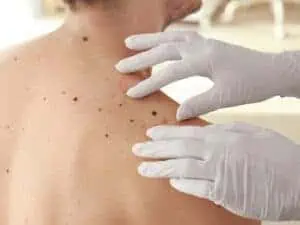
Worried about a mole?
A mole is a coloured spot on the skin which is made up of a cluster of cells known as melanocytes which are responsible for producing the pigment in your skin. Sometimes these melanocytes grow in a cluster instead of being spread out which results
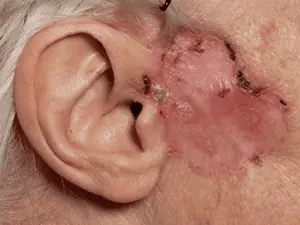
Is BCC (Basal Cell Carcinoma) a Completely Curable Disease? How?
You might not have heard of Basal Cell Carcinoma before, but it is actually the most common form of skin cancer in the UK. About 80% of the people who are diagnosed with skin cancer every year have a BCC. If you are diagnosed with








